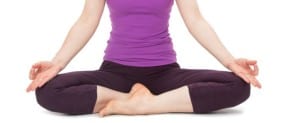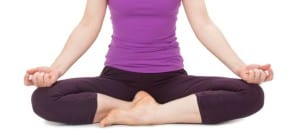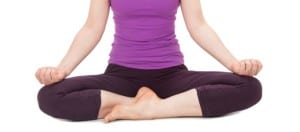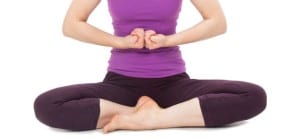When I first came across mudras I immediately noticed a subtle and deep shift in my experience and practice. They are one of the practices that make you realise that there is something very special about yoga. Yoga is a mystical tradition after all. (Traditionally mudras were considered so powerful that they were to be kept secret and only shared between teacher and student when appropriate).
Even if the word mudra seems unfamiliar, the chances are that we have seen – or practised – at least one or two.
Chin mudra, in which the tip of the first finger and thumb touch is often associated with an image of a yogi in meditation. Another commonly recognised mudra involves the palms joined together with the thumbs pointing towards the chest. This is atmanjali or hrdayanjali mudra (shortened to anjali mudra). If you fly to India you’ll probably be greeted with this hand gesture and a beautiful smile as you board the plane!
Mudras can be used in a therapeutic context, for example to increase focus, positivity and well-being or to ease tension or anxiety. They affect our energy and mindset, and help to balance the active and receptive parts of the nervous system. They encourage our parasympathetic responses, linked to our rest and digest state (rather than our fight or flight response).
The word mudra is commonly translated as ‘seal’ or ‘lock’. Mudras seal, direct, intensify and prevent the loss of prana, our energy or life force. They can be used to seal certain parts of the body and in hand gestures in which the fingers are placed in a particular way, at a particular point. As such, they can also benefit the health of our internal organs and systems.
Below is a simple sequence for you to try.
It can take a while to tune into the subtleties – and potency – of mudras, so don’t worry if it seems that nothing much is happening the first time or so. Quiet and a focused mind are needed. This sequence also strengthens our awareness of the breath in different parts of our torso, and the use of the various lobes of our lungs. This is all part of enabling us to breathe fully.
Sit in a comfortable position. If sitting with crossed legs doesn’t work for you, you can find some alternatives in the ‘posture’ section here so that the spine remains straight while the hips and knees are safe.
Note that the first three hand positions below can also be taken with the palms facing downwards, with the hands nearer the top of the thighs by the torso. This feels a little different, and is worth trying too.
While using each mudra, allow your mind to focus on the sensations of your natural, uncontrolled breathing. Where do you feel it most in your body?
Stay with each mudra for up to 10 breaths in and out.
1. Jnana / Chin mudra
Join the tips of the thumb and first finger. The palms face upwards in jnana mudra (seal of knowledge/wisdom) and downwards in chin mudra (seal of consciousness) – see which feels most natural to you. Palms up has a more external energy, palms down a more internal one.
Here you can feel the breath predominantly in the lower abdominal area, the lower sides of the body and the lower back. Awareness here, and abdominal breathing have a profoundly relaxing effect. Our emotional centre here, the solar plexus feels the calm of this practice.
2. Chinmaya mudra
The tips of the thumb and first finger touch. Gently curl in the other fingers.
With chinmaya mudra you can feel the breath in the intercostal area (the middle of the chest). Feel the breath in the front, side and back of the chest. Breathing here is said to benefit the health and function of the heart.
3. Adhi mudra
Curl in the thumb first, and then the other four fingers.
Adhi mudra accentuates the feeling of the breath in the upper chest, in the clavicular region. Breathing here helps with removing any congestion in the upper chest area.
4. Brahma mudra
Retain the same position of the fingers as above, and bring the backs of the hands together on the abdomen.
This brings the impact of all three previous mudras together, with a sensation of the fullness of breath and prana in the whole torso, and then extending throughout the body. Your lungs’ complete breathing function is enhanced.
And do you feel something else? Perhaps a deeper connection or merging of the prana within your body and the prana all around you? A melting of boundaries; spaciousness?
After your last exhalation in brahma mudra release the hands back to the knees (or thighs) and sit quietly for a few moments, drinking in all the prana and the sweetness of the practice. Observe how you feel. Beautiful isn’t it?
Please feel free to share this post and the magical practice of mudras with your friends. A new level of awareness awaits.
Photos: bellanova



